Embarking on an eagle poem joy harjo analysis is a journey into the depths of Native American culture, resilience, and the profound connection between humanity and nature. Through Harjo’s evocative imagery and masterful use of symbolism, we explore the soaring spirit of the eagle, a metaphor for strength, freedom, and the indomitable will to overcome.
Delving into the heart of Harjo’s poetic style, we uncover the intricate tapestry of her words, woven together with vibrant imagery, rich metaphors, and profound symbolism. Each element contributes to the profound impact and resonance of her poems, leaving an enduring mark on the reader’s soul.
Joy Harjo’s Poetic Style
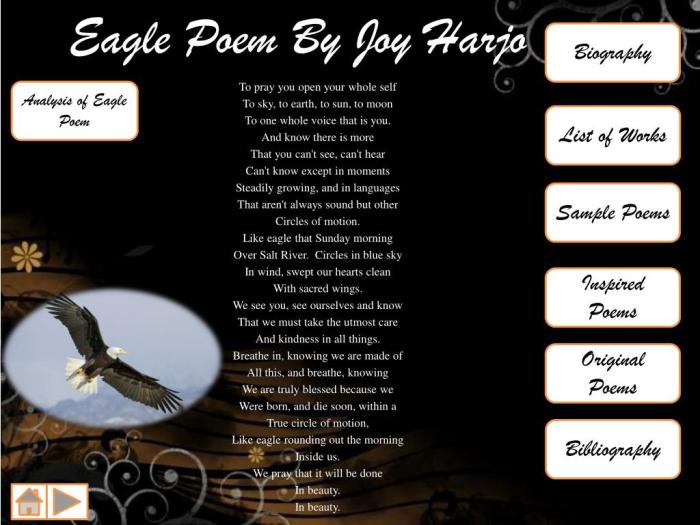
Joy Harjo’s writing style is characterized by its lyrical beauty, evocative imagery, and profound symbolism. Her poems often explore themes of identity, history, and the natural world, and her use of language is both precise and evocative.
Use of Imagery
Harjo’s poems are rich in vivid imagery, which she uses to create a strong sense of place and atmosphere. In “Eagle Poem,” for example, she describes the eagle’s “great wings” and “sharp eyes,” which evoke the bird’s power and majesty.
She also uses imagery to convey the eagle’s connection to the natural world, describing it as “a spirit of the wind” and “a creature of the sky.”
Use of Metaphor
Harjo also makes effective use of metaphor to create deeper meaning in her poems. In “Eagle Poem,” she compares the eagle to a “warrior” and a “seer,” suggesting that the bird possesses both strength and wisdom. She also compares the eagle’s flight to a “dance,” which conveys the bird’s grace and beauty.
Use of Symbolism
Symbolism is another important element of Harjo’s poetic style. In “Eagle Poem,” the eagle itself is a powerful symbol of freedom, strength, and spirituality. Harjo also uses the eagle’s feathers to symbolize hope and renewal, and the eagle’s nest to symbolize home and safety.
The Significance of the Eagle in Harjo’s Poetry
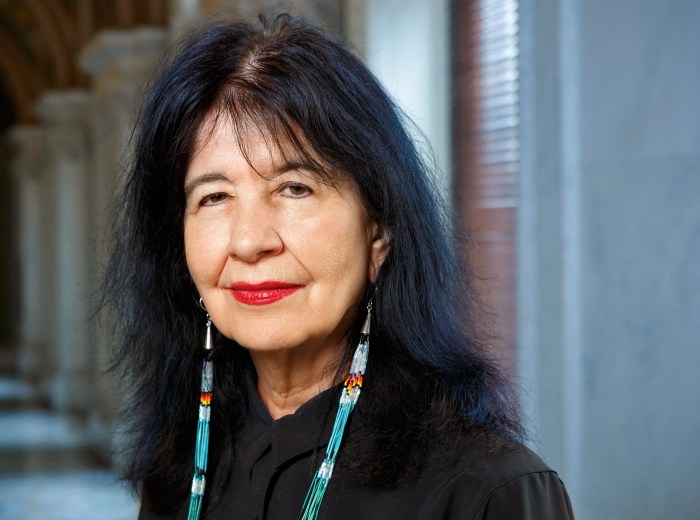
The eagle holds a profound symbolic significance in Native American culture, representing strength, resilience, and freedom. For Joy Harjo, an enrolled member of the Muscogee (Creek) Nation, the eagle carries personal significance as a symbol of her heritage and connection to her ancestors.
The Eagle as a Metaphor for Strength and Resilience
In “Eagle Poem,” Harjo employs the eagle as a metaphor for the indomitable spirit of her people. She writes, “The eagle does not get lost in the storm. / It rides the wind, / its wings spread wide.” This imagery evokes the eagle’s ability to withstand adversity, just as Native Americans have endured centuries of oppression and displacement.
The Eagle as a Symbol of Freedom
Harjo also uses the eagle to represent the aspiration for freedom and sovereignty. She writes, “The eagle flies above the clouds, / its eyes fixed on the horizon.” This image suggests the eagle’s ability to soar above limitations and seek a brighter future, a sentiment that resonates with the Native American struggle for self-determination.
The Eagle’s Presence in the Poem
The presence of the eagle throughout “Eagle Poem” enhances its overall message of hope and resilience. It serves as a constant reminder of the strength and spirit of the Native American people, reminding readers that even in the face of adversity, they will continue to soar.
The Role of Nature in Harjo’s Poetry

Nature plays a pivotal role in Joy Harjo’s poetic universe, serving as a potent symbol of identity, spirituality, and belonging. Through her lyrical depictions of the natural world, Harjo explores the interconnectedness of all living beings and the profound impact of the environment on human existence.
Nature as a Source of Identity
Harjo’s poetry draws upon the rich landscapes of her Muscogee (Creek) heritage, invoking images of rivers, mountains, and animals to evoke a sense of place and cultural identity. In “Eagle Poem,” the eagle is a central figure, embodying the strength, resilience, and sovereignty of the Muscogee people.
Harjo writes, “Eagle, you fly in my dreams,” suggesting a deep connection between her personal identity and the natural world.
Nature as a Spiritual Conduit
Nature is also a conduit for spiritual experiences in Harjo’s poetry. The natural world is often portrayed as sacred, imbued with a divine presence that connects humans to the cosmos. In “Eagle Poem,” Harjo describes the eagle as a “messenger from the spirit world,” suggesting its ability to transcend the boundaries of the physical realm.
Nature as a Reminder of Interconnectedness
Harjo’s poetry emphasizes the interconnectedness of all living beings, both human and non-human. Through her depictions of nature, she challenges the notion of human superiority and highlights the importance of respecting and preserving the natural world. In “Eagle Poem,” the eagle’s flight reminds us of our own vulnerability and the need to live in harmony with the environment.
Thematic Analysis of “Eagle Poem”
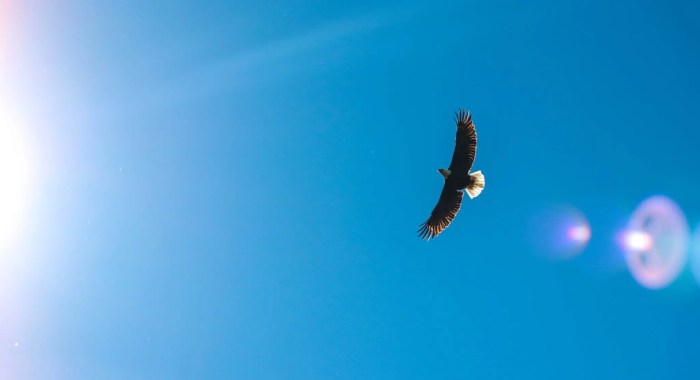
Joy Harjo’s “Eagle Poem” explores profound themes that resonate with her personal experiences and cultural heritage. The poem centers around the majestic eagle, a symbol of freedom, identity, and the untamed power of nature.
Theme: Freedom
The eagle embodies the unyielding spirit of freedom. Harjo writes, “Eagle flies on the wind, / wings spread wide, / a wild heart soaring high.” This imagery evokes a sense of liberation and boundless potential, reflecting Harjo’s own journey towards self-discovery and empowerment.
Theme: Identity
The eagle also serves as a symbol of cultural identity. For Harjo, the eagle represents her Native American heritage and her connection to the natural world. She writes, “Eagle’s eyes see far, / a thousand miles in every direction.” This line suggests that the eagle possesses a wisdom and perspective that transcends physical boundaries, mirroring Harjo’s deep understanding of her own culture and traditions.
Theme: Power of Nature
Throughout the poem, Harjo emphasizes the awe-inspiring power of nature. The eagle is depicted as a creature of immense strength and resilience, capable of weathering any storm. Harjo writes, “Eagle rides the wind, / a force of nature, / wild and free.”
These lines convey the untamed spirit of the natural world and its ability to shape and inspire human lives.
Form and Structure of “Eagle Poem”
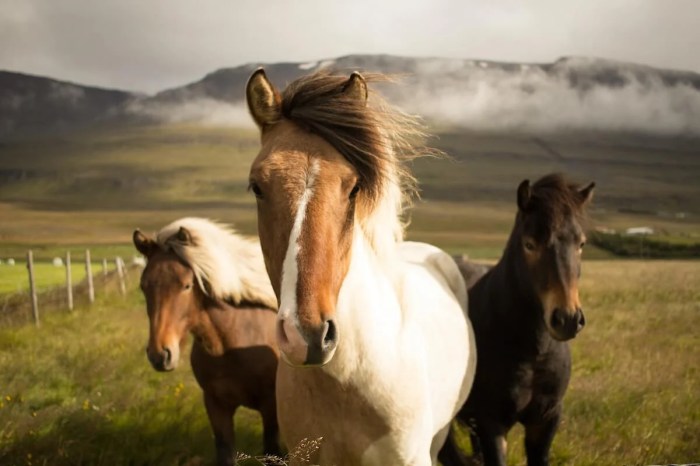
Harjo’s “Eagle Poem” is a free verse poem, characterized by its lack of a formal rhyme scheme or meter. This free verse structure allows Harjo to explore the poem’s themes and imagery in a more fluid and organic way.
Line Breaks and Stanzas
The poem is composed of six stanzas, each varying in length. The line breaks within each stanza are carefully crafted to create a sense of rhythm and flow. For example, the first stanza consists of short, choppy lines that mimic the soaring and diving motion of an eagle.
Poetic Devices
Harjo employs various poetic devices to enhance the poem’s musicality and meaning. Repetition, for instance, is used to emphasize key ideas and create a sense of incantation. Alliteration and assonance contribute to the poem’s sound patterns, making it more pleasing to the ear.
When delving into the symbolism of the eagle in Joy Harjo’s poetry, one may wonder about the significance of “126” in police code. This code, as explained here , denotes a priority response to a critical situation. Similarly, in Harjo’s work, the eagle represents a powerful force that responds swiftly and effectively to challenges, embodying the resilience and determination found in her poetic exploration.
Comparative Analysis of “Eagle Poem”
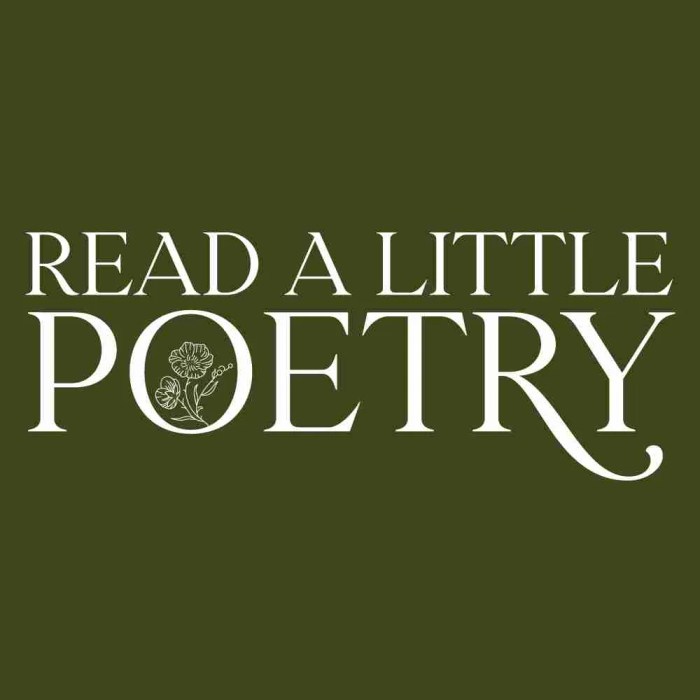
Joy Harjo’s “Eagle Poem” is a powerful and evocative work that explores themes of identity, resilience, and the interconnectedness of all living things. To gain a deeper understanding of Harjo’s unique poetic style and thematic concerns, it is valuable to compare “Eagle Poem” to another poem by Harjo or a different poet who explores similar themes.
One poem that invites comparison is “The Woman Who Fell from the Sky” by Native American poet Louise Erdrich. Like Harjo, Erdrich is known for her use of Native American mythology and imagery to explore themes of identity, loss, and survival.
In “The Woman Who Fell from the Sky,” Erdrich tells the story of a young woman who falls from the sky and is adopted by a Native American family. The poem explores the woman’s struggle to find her place in the world and her eventual acceptance of her identity as a Native American.
Similarities in Writing Styles
Both “Eagle Poem” and “The Woman Who Fell from the Sky” are written in a free verse style that allows the poets to explore their themes in a fluid and organic way. Harjo and Erdrich also use vivid imagery and sensory language to create a strong sense of place and atmosphere.
In “Eagle Poem,” Harjo writes, “The eagle’s cry / is a song of the wind / a prayer of the sun.” This imagery evokes a sense of the eagle’s connection to the natural world and its spiritual significance.
Differences in Use of Imagery
While both poets use imagery to explore their themes, Harjo and Erdrich have distinct approaches to imagery. Harjo tends to use more abstract and symbolic imagery, while Erdrich’s imagery is often more concrete and rooted in the natural world. In “The Woman Who Fell from the Sky,” Erdrich writes, “Her hair was the color of ripe wheat / and her eyes were the color of the sky.”
This concrete imagery helps to create a vivid picture of the woman in the reader’s mind.
Thematic Concerns
Both “Eagle Poem” and “The Woman Who Fell from the Sky” explore themes of identity, resilience, and the interconnectedness of all living things. However, Harjo’s poem focuses more on the eagle as a symbol of strength and resilience, while Erdrich’s poem focuses on the woman’s struggle to find her place in the world.
This difference in focus reflects the different experiences and perspectives of the two poets.
Harjo’s Unique Contribution, Eagle poem joy harjo analysis
The comparison of “Eagle Poem” to “The Woman Who Fell from the Sky” highlights Harjo’s unique contribution to contemporary poetry. Harjo’s use of abstract and symbolic imagery, her focus on the eagle as a symbol of strength and resilience, and her exploration of the interconnectedness of all living things set her apart from other poets who explore similar themes.
Harjo’s poetry is a powerful and important voice in contemporary American literature.
Question & Answer Hub: Eagle Poem Joy Harjo Analysis
What is the central theme of “Eagle Poem”?
The central theme of “Eagle Poem” is the exploration of freedom, identity, and the power of nature, particularly as it relates to the Native American experience.
How does Harjo use the eagle as a symbol in her poem?
Harjo employs the eagle as a potent symbol of strength, resilience, and the indomitable spirit, drawing upon its significance in Native American culture.
What is the significance of nature in Harjo’s poetry?
Nature plays a pivotal role in Harjo’s work, serving as a source of connection, identity, and spirituality, reflecting the deep bond between Native American communities and the natural world.
